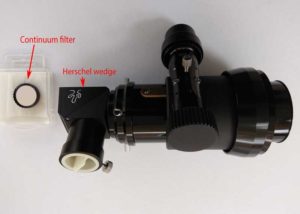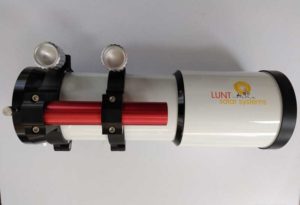1. Solar brightness and layers
The sun is so bright that it cannot be observed without special precautions.
There are also two layers with distinctive feature that we would like to observe separately. The photosphere and chromosphere are described in the section on the sun.
Solutions
To observe the chromosphere the bulk of the light from the photosphere must be removed as it masks the light from the higher layer. Fortunately much of the light from the chromosphere is produced by hydrogen emitting a narrow band of wavelengths. This band is not emitted significantly by the chromosphere. So the trick is to remove all the light except this narrow band. This is done in two stages.
- An Etalon…..An etalon is a resonant structure. It works by bouncing light back and forth between two partially reflective mirrors. When the cavity width is an integer multiple of half of the wavelength it will transmit light. Light not satisfying this criterion is reflected. Because light can be a multiple of half a wavelength then a number of narrow bands are transmitted by the etalon.
- A blocking filter’s job is to remove all the other bands other than the h-alpha band.
To observe the photosphere is is merely necessary to reduce the light intensity across the visible spectrum. Again this is done in two stages in the particular set-up I use.
- A Herschel wedge. This is a prism shaped like a wedge which refracts most of the light out of the path whilst just reflecting a small proportion.
- A continuum filter transmits a specific spectral region around 540nm (green). It is able to boost contrast and reduce the effects of atmospheric turbulence.
To allow for these changes the Lunt telescope is designed to change the lower prtion of the tube assembly. One assembly has the Etalon and the blocking filter. The other has the Herschel wedge. The continuum fliter is a 1.25″ device that screws into the eyepiece or the camera. The third image below is the part of the assembly that contains the objective lens and is common to both arrangements.



2. Problems with relative brightness
When imaging in h-alpha the prominences are very much less bright than the surface. So ant image that shows the prominence necessarily distorts relative brightness.
Solutions
It is possible in processing software to bring out the prominences to a degree. In these cases it seems possible to get more detail but at the expense of being faint. Another solution is to take two images, one which gets the exposure correct for the surface and a second that increases the exposure or gain to get an image of the prominence. This makes the surface completely saturated of course. The method is described in the section taking solar images. The are sharpened and combined as described in the section processing solar images.
3. Problems with orientation
To start with I just took images that seemed interesting not worrying about the orientation of the camera. This soon showed itself to be a mistake as it is good to be able to compare from day to day – particularly sunspots. It is important to make a consistent alignment by rotating the camera until one of the two axis is parallel to the EW movement of the sun across the sky.
Solution
Rotate the camera until, when pressing the east/west keys on the handset, a feature on the sun moves horizontally on the screen. I then know that this axis of the image is aligned east/west. The axis of rotation of the sun is at an angle to this that only changes slowly from day to day. Helio is a program written by Peter Meadows that gives this, and much else, for any particular time and date.